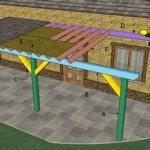How To Remove Moss From Patio Slabs
Moss, while aesthetically pleasing in some settings, can create a slippery and hazardous surface on patio slabs. Its presence can also detract from the overall appearance of a paved area. Effective moss removal requires understanding the underlying causes and implementing appropriate methods, which range from simple manual techniques to the application of specialized cleaning solutions.
Manual Moss Removal
Manual removal offers an environmentally friendly and often effective approach for treating moss, particularly when dealing with smaller areas or less stubborn growth. Using a stiff-bristled brush, such as a push broom or deck scrub brush, apply firm pressure and scrub in a back-and-forth motion. This physical action dislodges the moss from the slab surface. A garden hose can then be used to rinse away the detached moss. For more persistent moss, a scraper, preferably plastic or wooden to avoid scratching the slabs, can be used to lift the moss from the surface.
Regular sweeping and brushing can prevent the buildup of organic matter and moisture that promotes moss growth. This preventative measure, performed weekly or bi-weekly, can significantly reduce the need for more intensive cleaning methods.
Chemical Moss Removal
Several chemical solutions are available for moss removal. These products typically contain ferrous sulfate, which is effective at killing moss. Always follow the manufacturer's instructions carefully, paying close attention to recommended dilutions and safety precautions. Applying these solutions usually involves spraying the affected area evenly and allowing the solution to dwell for the specified time. After the dwell time, rinse the area thoroughly with a garden hose to remove the dead moss and chemical residue. It's important to be aware that some chemical moss killers can affect surrounding plants, so it’s advisable to protect nearby vegetation or choose a more targeted application method.
When using chemical solutions, always wear appropriate protective gear, including gloves, eye protection, and long sleeves. Ensure adequate ventilation and avoid contact with skin and eyes. In case of accidental contact, rinse thoroughly with water and seek medical advice if irritation persists.
Pressure Washing
Pressure washing provides a powerful method for removing moss and other stubborn debris from patio slabs. A pressure washer uses a high-pressure stream of water to blast away the moss and clean the surface effectively. However, it's essential to use caution when pressure washing, as excessive pressure can damage some types of paving slabs. Start with a lower pressure setting and gradually increase as needed, observing the slab's reaction to the pressure. Use a wide-angle nozzle to distribute the pressure more evenly and reduce the risk of damage.
Before pressure washing, clear the area of any loose debris, furniture, or plants. It is advisable to test the pressure washer in an inconspicuous area first to ensure it does not cause any damage. After pressure washing, rinse the area thoroughly to remove any remaining moss and debris.
Natural Moss Removal
For those seeking a more eco-conscious approach, several natural methods can be employed for moss removal. A mixture of baking soda and water can be applied to the moss, allowed to sit for a few hours, and then scrubbed away. White vinegar, diluted with water, can also be effective in killing moss. These natural solutions offer a less aggressive approach and are less likely to harm surrounding plants or the environment.
When utilizing baking soda or vinegar solutions, it's important to understand that they may require multiple applications, particularly for stubborn moss. Regular application and subsequent scrubbing are key to achieving desired results. These natural solutions are best suited for smaller areas or as a preventative measure against moss regrowth.
Preventing Moss Regrowth
After removing moss from patio slabs, implementing preventative measures can help minimize regrowth. Improving drainage and reducing moisture buildup are crucial. Ensure that gutters and downspouts are clear and direct water away from the patio area. Trimming overhanging branches can increase sunlight exposure and reduce dampness, making the environment less hospitable for moss. Applying a sealant to the patio slabs can also help prevent moss from taking hold.
Regularly sweeping or blowing away leaves and other debris minimizes organic matter accumulation, which contributes to moss growth. Periodic applications of a moss-preventing solution can also help maintain a moss-free patio. These solutions typically create a less favorable environment for moss growth, reducing the likelihood of recurrence.
Choosing the right moss removal method depends on the severity of the moss growth, the type of patio slabs, and individual preferences. By considering these factors and understanding the various methods available, one can effectively remove moss and maintain a clean and safe patio surface.

How To Remove Moss From Concrete 6 Solutions And Tips

How To Kill And Prevent Sidewalk Patio Moss

How To Get Rid Of Moss Landscapers Share 42p Remove Paving Express Co

Best Tips On Cleaning Patio Slabs How To Get Rid Of Algae

How To Remove Moss From Pavers Paver Installation San Diego

Remove Algae And Lichen Off Patio Pavers Like Rick Wet Forget Blog

How To Clean Your Patio And Kill Moss Red

Remove Moss From The Garden And Roof Kärcher

How To Remove Moss Between Patio Stones

How To Remove Moss From Paving And Concrete Without A Pressure Washer Or Scrubbing Express Co
See Also








